A 17th-century molave relleve (bas relief), with the defaced images of two women greeting each other, intrigues the onlooker. The women’s noses are flattened and half of their eyes and cheeks are sliced. Writer/director/culture polymath Floy Quintos sees only the patina of age and the tiny cracks and scratches that lend character to the piece.
“I have two theories,” he says. “It’s the Visitation (the Virgin Mary’s visit to her cousin Elizabeth), or Santa Ana, Mary’s mother, visiting Mary. What is interesting is that their faces were most likely hacked during the Philippine Revolution.”
Quintos earlier opted to hold this interview at his shop, Gallery Deus, at Faura Mall in Ermita, once the bastion of the antiques trade. The shop is overcrowded with indigenous and colonial relics, randomly displayed instead of being arranged in the conventional (orderly) fashion of visual merchandising. On Saturday mornings, he meets up here with some serious collectors for shop talk.
With 40 years of collecting behind him, Quintos, 60, has become a resource person for the gamut of indigenous art. He has delivered a lecture on the bulul (rice granary gods) from the north at Ayala Museum, and curated exhibits, one at Makati’s Yuchengco Museum that spotlighted the silk trade of the Muslim south, and another one of anting-anting (mystical amulets) from the Philippine lowlands at Musée du Quai Branly-Jacques Chirac in Paris.
Part of the wonder
At Gallery Deus, we espy angels with time-worn skins and three crudely proportioned antique Magi from Paete, Laguna, as well as hardwood miniatures of San Nicolas Tolentino and a rare San Pablo and San Vicente from Panay, with severed hands and crude facial features.
Quintos explains: “They appeal to me, the mamarracho (bad art) types or the imagenes repulsivas (repulsive icons). Those considered ugly, made by untrained sculptors, reveal a lot about the Filipino psyche—how we view God, how we traverse the worlds of the animist, the colonials and Catholicism. What I like about every object is that it reveals the sculptor’s world view. Among the santos (Christian images), I never was into ivory or ornate images. To see a piece just as a beautiful thing is a disservice to it. I go deeper; I’m attracted to objects that speak to me.”
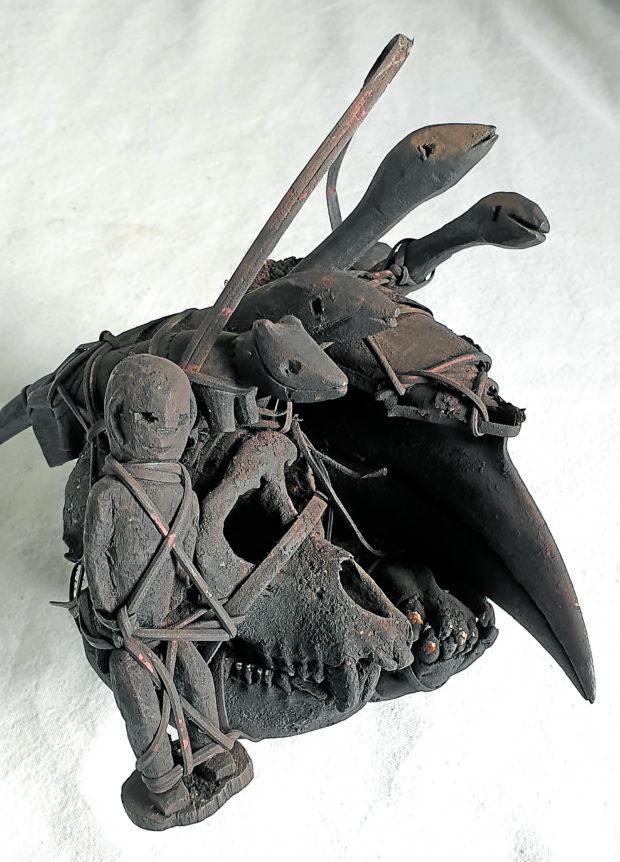
When Ermita was the antiques trade center in the late 20th century, young Quintos roamed the area, looking around the shops and immersing himself in another world. He made friends with Cordillera culture expert Henry Beyer (grandson of Henry Otley Beyer, father of Philippine anthropology), and dealers/connoisseurs Terry Baylosis, Antonio Martino, Willy Versoza, et al. Over time, Quintos likewise built a network of tradesmen, merchants and runners who brought him cultural objects.
“That’s part of the wonder of the experience,” he says. “You meet people and get to ask questions.”
Quintos vaguely recalls his first acquisition. “It was probably a small santo which I bought for P5 in Ermita,” he surmises. Then he started collecting bulul, and finally ventured into ritual objects, textiles, household utensils, baskets. Because of their delicate nature, he relates, the textiles had to be stored in baul (wooden trunks) and camphor chests.
He did not need a deep pocket to start acquiring, he adds. “Philippine collectors did not value many objects that weren’t considered ‘blue-ticket’ or status items, although they should have been, like the silver paliteras (toothpick holders) and the mesa altar (altar table carved from exotic hardwood).”
Quintos has accumulated objects prized as much for their ethnographic as for their aesthetic values.
Smartphone documentation
His collection of 250 rare textiles has been displayed in the country’s major museums. Fabrics from the north were lent to Museo Kordilyera in Baguio. He grouped his Mindanao fabrics into three categories—animists of the uplands from such tribes as the Bagobo, B’laan and Mandaya; silks and malong (tube skirts) from the Islamic Maranao and Maguindanao culture; and weaving from the Yakan and Tausug. The entire textile collection now belongs to art patroness Mercedes Zobel, and is set to be displayed at the newly renovated Ayala Museum.

Among fabrics from the north, Quintos favors the weaves of the Itneg group from Abra over inabel Iloko. Horses, human figures and rivers in complex weaves originated in Abra, he points out.
“Inabel Iloko was a colonial thing,” he says, adding that the fabric flourished when the Spaniards introduced their box looms and weaving accessories to the region. “It’s interesting how the Ilokanos appropriated the patterns from the Itneg.”
Documentations of Quintos’ fabric collection venture are stored in his smartphone. Among the outstanding entries are the malong landap and malong a andon. A symbol of royalty among the Maranaos, the landap sports solid colors contrasted with decorative strips of intricate okir (foliate) patterns. The rarest, malong a andon is valued for the complexity of the ikat silk process. The designs are characterized by symmetrical florid patterns, inspired by Indian trade cloths.
Quintos recalls that the 2017 “Silken Courts and Mindanao Tapestry” exhibit at Yuchengco Museum was highlighted by a canopy featuring the image of the buraq, a winged mule with a female head that, it is said, the Prophet Mohammad rode to heaven.

“What interests me most about Islamic art in the Philippines,” he muses, “is that we were so far away from the center of Islam, that Filipino Muslim artists created their own language which was declared haram (forbidden) in the Middle East. Living—including human—figures were not supposed to be depicted in art, yet that’s what happened. The okir developed because depiction of animals was haram.”
Muslim fundamentalists and Filipinos who studied in Saudi Arabia would resist the portrayal of animals in art, including the Sarimanok (legendary bird of the Maranao people), based on the belief that only Allah can create living beings. The fluid arm movements in the pangalay (fingernail dance from Sulu) are considered sensual and the dancing between a man and a woman, as in the princess and the prince in the Singkil (a Maranao dance based on an epic), is taboo.
“These objects and textiles represent a lifestyle that is fast becoming extinct,” says Quintos. “It is not being wiped out by technology or lack of support by private individuals, but by fundamentalism. The same thing happened in the Cordilleras from the 1970s to the ’90s on account of the Born Again movement. The bulul and rituals were considered profane.”
Provenance defines value
He is modest about his noteworthy collection of bulul, but Quintos is proud of a book that he wrote, “Provenance: Ramon Tapales,” a monograph of rare artifacts once owned by corporate executive Ramon Tapales.

The coffee-table book was launched in time for the pioneer collector’s 80th birthday in 2014. In the ’70s and ’80s, Tapales focused on Cordillera artifacts, many of which were subsequently cited in museum publications. Intuitively, before selling them, Tapales had each object documented by his brother, photographer Boldy Tapales.
The monograph underscores how the origin of an object defines its value. A relic acquired from a knowledgeable source is labeled “an objet d’art with provenance.” A similar object bought from a curio shop is “an ethnographic specimen.”
Quintos writes, “Sotheby’s will devote a catalog cover and many glossy pages of research to the former. The latter will end up on eBay.”
An ancient bulul could fetch about seven figures. Their marketability has led to the influx of fake objects, says Quintos. “Philippine tribal art is harder to understand than the santo or the furniture. Proportions, marks of use, and wear and tear can be duplicated. My constant advice is, ‘Don’t buy a bulul, buy all the books instead. Train yourself—before buying.’”
As a collector, Quintos read early 20th-century researches by American anthropologist Roy Franklin Barton.
He explains the bulul mystique: “The bulul from the 19th century—or the archaic—is the world standard. Ancient bulul were not randomly carved. Every step of their creation involved a ritual, from finding the right narra tree and the felling of that tree in accordance with prescribed rites. When the mumbaki (shaman) carved the bulul deep in the forest, he abstained from specific foods and sex. He was supplied with rice wine and betel nut, which were a potent force. The process of carving happened in an altered state, which was reflected on the faces of the finished figures. On their torsos would be left adze (primitive carving tool) marks. A genuine bulul will not be polished or smooth. It has no obligation to be beautiful for anyone.”
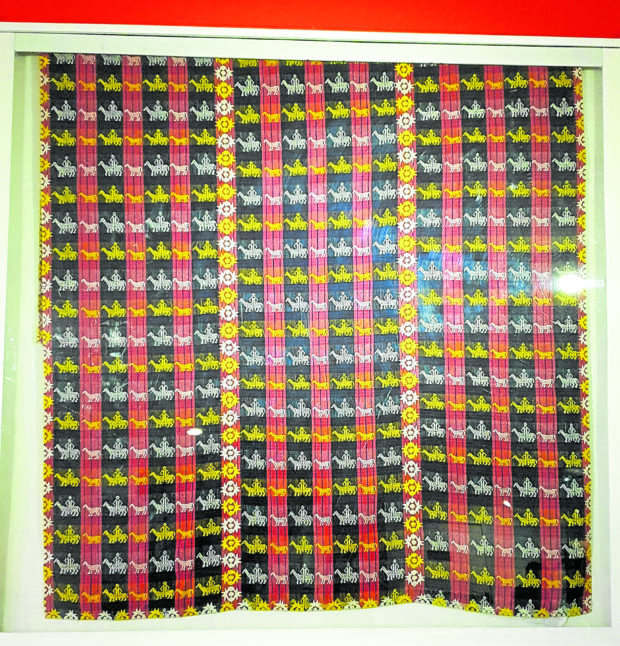
Quintos proceeds to show some of his Cordillera favorites, such as the burlwood bowl with ergonomic design for slip-proof handling, a smooth, shallow plate from the Kankanaey tribe and a star-shaped food bowl carved with bulul figures. The quality of each one’s finish nixes the misconception that indigenous objects are crude. He points out that artisans are capable of producing objects of refined quality.
From his cupboard, Quintos brings out objects of sorcery fashioned by the Ifugaos. He likens a fetish object incorporating a monkey, a hornbill and a dog to a “power bundle,” and stresses a precious lesson: “Part of the joy in collecting is the learning. The Ifugaos in traditional society, as in most Southeast Asian cultures, were headhunters.”
The role of headhunting in said cultures was ritualistic; It reinforced hierarchy in relationships and order between tribes and individuals. The head carried the life force of the deceased.
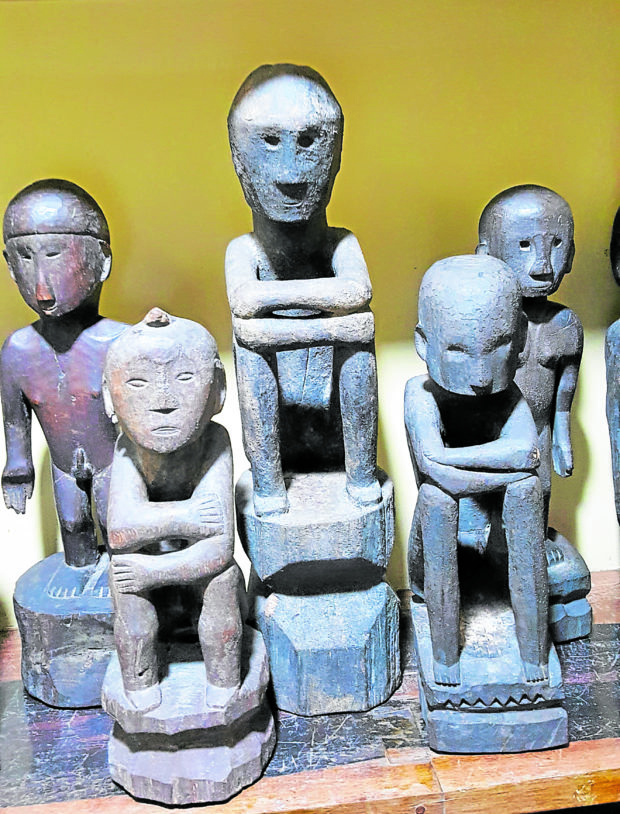
“If the head was severed and the body was found, headhunters incited ‘revenge spirits’ to help them,” says Quintos. He proceeds to show an Ifugao armlet previously worn by a warrior believed to have supernatural powers. “When I started getting into sorcery objects, nobody cared.”
Facets of Filipino mystique
Quintos’ anting-anting collection shows another facet of the Filipino mystique. In 2019, the exhibit at Quai Branly-Jacques Chirac in Paris, which specializes in the world’s indigenous arts and cultures, was titled, “Anting-Anting (The Secrets of the Filipino Soul).” The pieces came in the form of crosses, medallions, vestments with religious symbols and other Christian iconography. Beyond providing fortification for the wearer, Quintos notes, the anting-anting reveal the Filipino’s belief in the soul, a Supreme Being and nationhood.
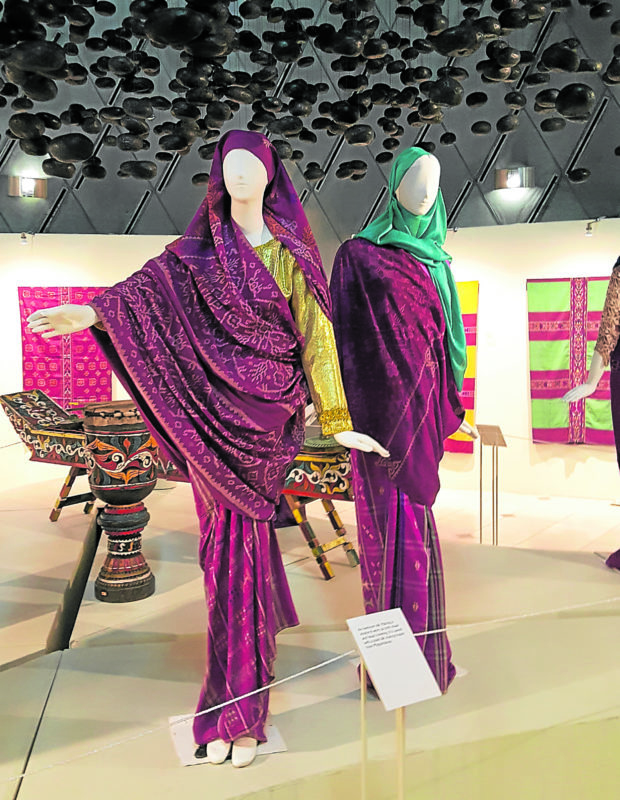
“It is the language of the oppressed and the marginalized. The anting-anting is a crossover— animism melded with Catholicism,” says Quintos. He cites Infinito Dios, or Bathala, who predates the Christian God. The story goes that Jesus, as God, created the world only to discover a Higher Power named Infinito Dios that wouldn’t submit to Him. Jesus tries to coerce Infinito Dios into being baptized. The latter acquiesces, but allows only His finger to be baptized. The Infinito Dios myth is an allegory of how Christianity subjugated the Filipinos who went on to meld catechism with ancient beliefs.
Quintos elaborates: “For the mag-anting-anting club, Infinito Dios is Bathala in a different form. This is subterfuge. What I love about the anting-anting are the components of secrecy and rebellion. We look at anting- anting today as protection or bringer of wealth. The oldest anting-anting reverted to the value of pagbabalik-loob, a return to the original self.”
A desire to understand
Quintos’ collections have informed his professional work. Directing the opening rites of the 2019 Southeast Asian Games, he flashed images of indigenous fabrics on giant LED strips.
He currently writes and directs the documentary series “Dayaw,” about living traditions and national treasures from ethnolinguistic groups. With its 12th season to be aired in August, the series is funded by the National Commission for Culture and the Arts and hosted by Aklan Rep. Loren Legarda.
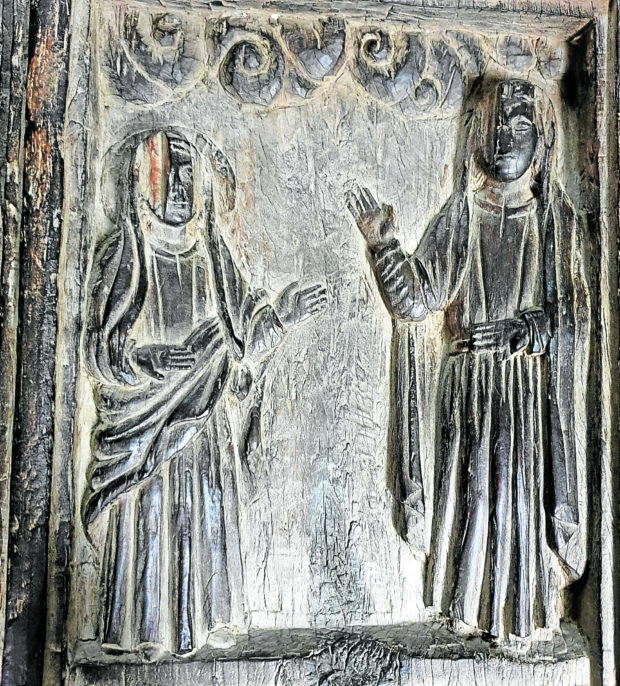
When the Department of Foreign Affairs (DFA) celebrated the 123rd Philippine Independence Day, he conceptualized and megged the cultural presentation, “Lessons for a Changed World: The Legacy of the Indigenous Peoples of the Philippines.” Explains Quintos: “The DFA launched 2021 as the Year of Philippine Precolonial Ancestors, but nobody seems to know or care. Still, we have to promote that. In [another platform], the success of ‘TRESE’ (an animated film series on the supernatural) points to a desire to understand elements of the indigenous and folk culture.”
Asked how he manages to accumulate a diverse and organized collection despite such a busy schedule, he replies, “I’ve been doing that since I was 20. I love things simply because they are beautiful, chipped or important. Once something has become part of my life, I become detached and let go. I never delude myself into believing that it will stay with me forever.”
Are there other things that delight him to the same extent now?
“Japanese studio pottery pieces bought from Facebook Marketplace. They amuse me; I can get signed pieces for P500 to P600. They’re cheerful, fun and cheap. I can also put them away after I enjoy them.” —CONTRIBUTED INQ













































